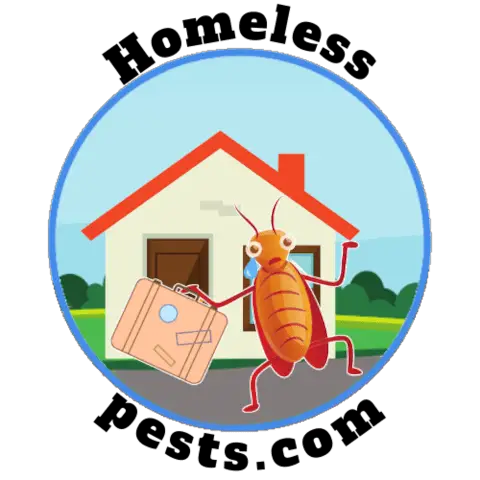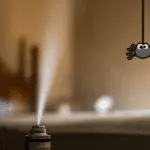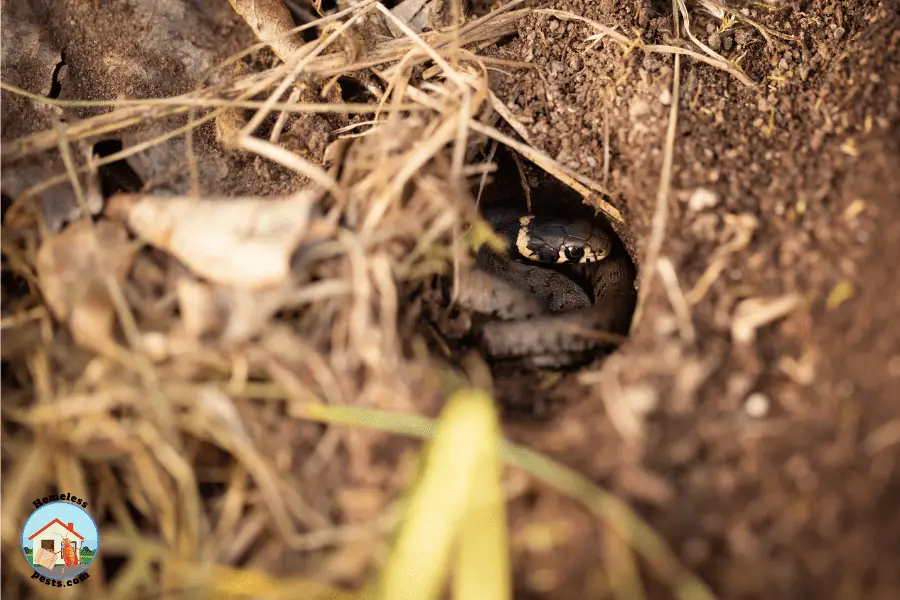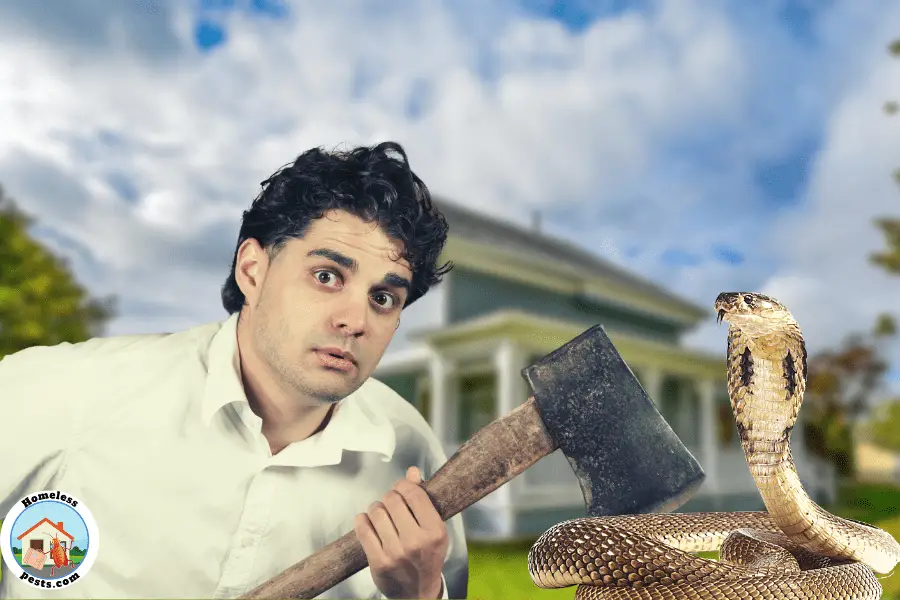There is nothing more frightening than discovering a snake in your home, especially if you have small children. While snakes are often feared, they are actually harmless if left alone.
If you do happen to find a snake in your home, however, it is important to know what to do. In this guide, we will teach you how to identify whether or not a snake is in your home and what to do if one is found. Stay safe and don’t panic – snakes aren’t always as scary as they seem!
How to tell if you have snakes in your house
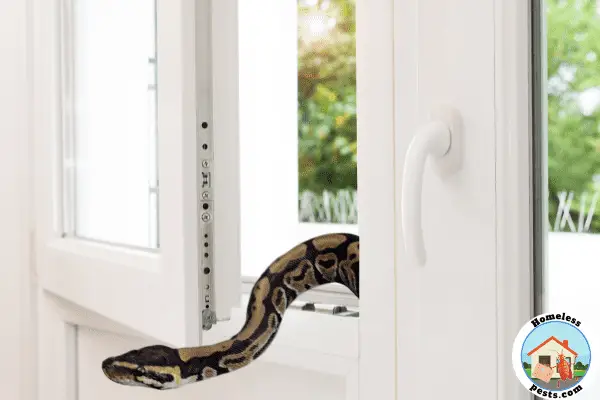
If you’re like most people, you probably don’t give much thought to snakes until you see one slither by. The United Snakes is inhabited by many different types of these critters (see this list of over 130 venomous and nonvenomous snake species and where they’re found), but not all of them are dangerous to humans. In fact, most snakes found in residential areas are harmless.
But what should you do if you think there are snakes in your house? Well, if you have your suspicions, you will probably want to first verify that you do have a snake roaming your property.
Below are some of the sure signs of finding snakes in the home.
Finding newly dug strange holes in the yard
When snakes take up residence in a new area, many species will first create a ‘burrow’ or ‘den’ – known as a snake hole. If you find a series of small, newly dug holes in your yard, it’s possible that a snake has moved in and is using the space as its home. If they are outside, then it doesn’t take much for them to find their way into your home as well. If you want more information on identifying snake holes, then read my full article on “snake holes in your backyard“
Noticing an increase in the number of rodents on the property
Although not always an indicator of a slithery serpent in the vicinity, a lot more mice, rats, and other rodents scurrying around than usual can be a tell-tale sign that there are snakes about. This is because rodents form part of a snake’s diet, so an increase in their population may attract snakes to your property in search of food. One of the best ways to prevent a snake infestation is to keep your property free of rodents by using traps and baits.
Hearing strange noises coming from the walls or ceiling
Snakes can hiss, rattle, grow, shriek, and make farting noises. A crinkling paper noise or a scratching noise similar to sandpaper when in use are also some of the noises a snake is likely to produce when it’s slithering or in motion.
All of these noises tend to sound unfamiliar to people. You will often hear these types of sounds coming from a cracked wall, a hole, a dark corner, or in a cluttered space.
Spotting the presence of hollow tube-shaped patterned skin
Snakes will shed off their skin once it’s old or when they have outgrown it. So finding or spotting a hollow tube-shaped skin is another sure sign that you have a snake(s) in your house.
Observation of snake poop
Another confirmatory sign of the presence of a snake in your home is the observation of dark brown poop, which may contain hair or bones. Snake poop is dropped in piles and usually found in the same area where they sleep or hide.
What to do if you have snakes in your house?
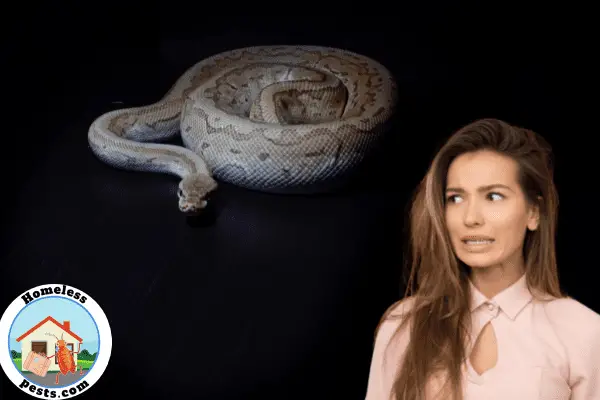
It’s possibly the worst thing to discover and it will set off your primeval fears, but you must stay calm and be brave. Honestly, the snake is not going to be that interested in you unless you startle it.
First, if possible, try to identify what type of snake it is. I would not recommend getting too friendly with any snake you find, but some snakes are very deadly and it’s best to know what you are dealing with.
If you can safely get a look at it, try to note the size, color, and any patterns or markings on its body. This will help you to determine whether or not the snake is venomous. If you’re unsure, you can check my photo identity parade for common snakes found in the United States.
Your best course of action is to leave the snake alone and make sure you leave all doors and windows inside closed so it can’t get into the rest of the house. If the snake is already near an exit, maybe leave that open!
If you have small children or pets, then you will need to take extra precautions to make sure they don’t come into contact with the snake. It might be better for you to leave the house in these circumstances and simply call someone.
Do not try to corner the snake or aggressively chase it. Doing so may result in a very hostile confrontation. And well, we both know who will be the likely winner, especially if the snake is venomous.
If you are dealing with a non-venomous snake (check my state by state list here), you might consider trapping it by using a bucket and placing weights on it as you wait for help to arrive.
And in case you suspect or spot a snake in your home’s wall, it is advisable that you call animal control or a wildlife removal service as they will have the experience and equipment to safely remove the snake from your home.

How do snakes get in the house?
Snakes are masters of getting around their habitats to find food, and this can sometimes include your home. If there are rodents or other small animals around your property, snakes may be attracted to the area in search of a meal.
Snakes can also enter through cracks and holes in your foundation or any other opening that provides them access to the inside of your home. Once they’re inside, they can be very difficult to find and remove.
The most common ways that snakes gain access to a home are below:
• Glide into your attic or basement
• Slither through cracks and crevices in your wall(s)
• Squeeze in the small space(s) under your door
• Climb through your bathroom’s drainage system into your toilet (possible, but not common)
• Come in through an open door or window
Now that you know how snakes can get into your home, let’s take a look at some of the places they love to hide.
What are some common hiding spots for snakes?
Once a snake is inside your home, it will likely be looking for a place to hide. Some of the most common hiding spots for snakes are:
• In or under furniture
• In closets or drawers
• Behind appliances
• Inside boxes and storage containers
• Underneath piles of clothes or towels
• In attics or crawl spaces
If you think there’s a possibility that a snake is in your home, it’s important to check these areas carefully. Snakes are often found in the same area where they sleep or hide.
How to tell if you have snakes in your backyard
The telltale sign that you have snakes in your backyard is spotting snake holes in your backyard. Typically snake holes closely resemble holes that are dug up by moles. These holes are often circular in shape and vary in size and are most often found near tree trunks, cluttered spaces, grassy spots, and large concrete cracks.
In case you find a snake hole covered in spider webs, or it has debris and leaves in it, then it’s safe to assume that it’s unoccupied by a snake. The presence of snake poop (which is usually dark brown and turns chalky when it’s dry) and shed snake scales around or near a snake hole(s) are a sure sign that you may be having snakes in your backyard.
For more information, feel free to read the following articles:
Other Articles to read on snakes as pests:
- Easy Ways To Identify Snake Holes & What To Do Next
- Identity 130+ Snake Species From The USA (With Images)
- Killing Snakes On Your Property – Advice To Save Your Life
- The Complete Guide On How To Find Snake In Your Home
How to prevent snakes from getting into your house
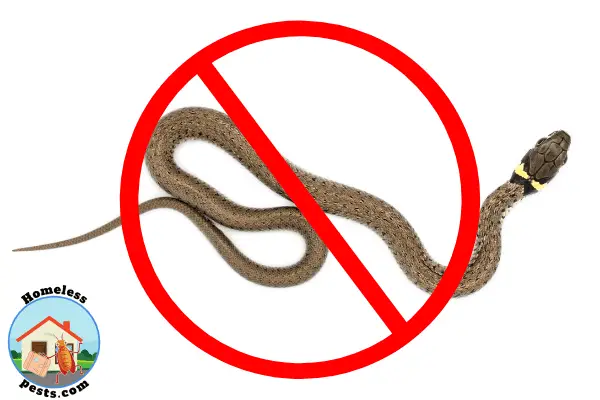
Even if you don’t turn out to have any snakes in your home today, they can always find their way in sometime in the future. So, what can you do to prevent snakes from getting into your house?
Keep your property and home clean and well maintained
Since cluttered spaces or compounds provide snakes with the much-needed shade and camouflage, ensure that you maintain an ideally clutter-free compound or home. Make sure that you regularly mow your grass, get rid of accumulating tree leaves or debris around your home, and routinely empty your trash bin.
Unattended trash bins act as a source of food for rodents, which in turn serve as a source of food for snakes. This consequently makes your home a snake ‘magnet’.
It’s also essential that you have trees and edges surrounding your home regularly trimmed; this ensures that you don’t provide snakes with any living habitat. Planting trees or flowers at least 15-20 feet away from your house is another intelligent way of preventing snakes from getting into your home.
Seal any entry points for snakes in your home
Physically prevent snakes from gaining access into your home by sealing any entry point(s). Patch up any holes, cracks, and crevices with premium sealants. Proof your home by having a pro install a snake fence. These physical barriers will go a long way in keeping snakes far away from your home.
Install screens on all windows and doors
Another surefire way of preventing snakes from getting into your house is by installing screens on all windows and doors. Although this won’t seal off your home completely, it will significantly reduce the number of entry points for snakes.
Use a lawnmower
Using a lawnmower temporarily prevents snakes from gaining access to your residence. The vibrations made by a lawnmower scare off snakes which might have made your home their habitat.
Utilize snake repelling plants
Consider growing the following snake repelling plants around your home or in areas that you feel are prone to snake infestation;
• Marigold
• Snake plant
• Indian snakeroot
• Mugwort
• King of bitters
To fully snake-proof your home by using snake repelling plants, please consider growing 2-3 of the plants mentioned above in containers and strategically placing them in your windows and doors.
Note: In some cases, certain chemicals found in these plants may be harmful to pets or children. So please exercise caution when using them.
Use snake repellents

Shop on Amazon.com
Another way that you can prevent snakes from getting into your house is by using snake repellents. There are different types of snake repellents available on the market today; choose the best one based on your needs and preferences.
Common snake repellents include:
• Mothballs
• Sulphur
• Ammonia
• naphthalene balls
• Snake away granules
Note: Please be very careful when using these chemicals, as some of them may be harmful to pets or children.

What to do if you are bitten by a snake

Firstly, let me make it clear that I am not a doctor, so this is not medical advice. The other thing to note is that of the many snake species present in the USA most are from the Colubridae family, which are mostly harmless to humans.
This might mean they don’t have harmful venom, but it doesn’t mean they don’t have fangs which can cause a serious wounds. A dry bite (when a snake bites but doesn’t release venom) can still hurt!
So, with that being said, here’s what you should do if you’re bitten by a snake:
Move to a safe distance and call 911
IMMEDIATELY MOVE TO A SAFE DISTANCE IN A BACKWARD Motion and call 911 and inform them that a snake has bitten you. It could also help to describe the type of snake that has bitten you and the time that has elapsed since the bite occurred to the 911 operator. This lets the response team know which snake bite kits to bring and evaluate the snake bite’s urgency.
Relax and limit your body movement
It’s vital that you keep calm and limit your body movement as much as possible after a snake bite episode. Please note that if you panic or move about, you will increase the rate at which the snake venom spreads in your body, due to increased blood circulation. Make sure that you also position your body with the bite below the heart level.
Remove any tight clothing or jewelry
Immediately after a snake bite, make sure that you remove any fitting clothes and jewelry. It helps prevent any form of injury to your skin just in case swelling occurs.
Extra tips; Never do the following after a snake bite incident;
- Apply pressure on the bite site
- Try and suck out the venom (because you’ll get it in your mouth!)
- Assume everything is fine and stay at home
- Chase after the snake to get rid of it or
- Try to kill the snake to identify it (take a photo instead)
- Take any medications before consulting a certified doctor
Should you attempt to remove a snake on your own?
I have suggested that very confident people attempt to trap a snake, but this has its risks. Should most people try to remove a snake?
You should NEVER attempt to remove a snake on your own unless you are a snake expert handler, or you are well versed with the different types of snakes, and you are sure you are about to handle a non-venomous snake. Always consider calling in for the services of guru snake catchers and let them handle it for you.
If you absolutely have to remove a snake on your own, here’s how to go about it; however, it is NOT recommended.
The net method

Shop on Amazon.com
If you happen to have a net or a bin bag or pillowcase you can attach to a long stick, then this is a relatively easy way to remove the snake from your property.
First, find the snake and try to keep it in your sights. Once you have a good idea of where it is, extend the net or bin bag towards it, being careful not to scare it off.
If all goes well, the snake will slither into the bag and you can simply lift it up and take it away.
The bin and broom method
If you don’t have a net, then you can try and sweep the snake into a bin using a broom.
First, find the snake and try to keep it in your sights. Once you have a good idea of where it is, extend the bin towards it, being careful not to scare it off.
Then, very gently nudge the snake towards the bin with the broom until it slithers in. You can then close the lid and take the bin away.
The pin and pray method

Shop on Amazon.com
If you don’t have anything to put the snake into or coax it into, then your only other option is to pin it down with a stick and hope for the best.
Find a long, sturdy stick (ideally one shaped like a Y) and approach the snake carefully. Once you’re close enough, quickly place the stick behind its head and apply pressure to stop it from moving.
Then, use your free hand to grab the snake behind its head (again, being careful not to get bitten) and lift it up. Take it away from your property and release it into the wild.
There you have it – three different ways to remove a snake from your property! If you find yourself in this situation, remember to stay calm, be careful and take your time. And if in doubt, always call a professional.
What’s the best way to trap a snake?
There are a few ways to trap snakes if you need to. The most common and probably the easiest is to use a snake trap.
These work by luring the snake into a box or cage with an enticing smell, such as food. Once the snake is inside, the door shuts behind it, preventing it from getting out.
You can buy snake traps from most hardware stores, or you can make your own using a cardboard box and some duct tape.

Shop on Amazon.com
Another way to trap a snake is to use a glue board. These work in a similar way to the snake trap, but instead of a box or cage, the snake gets stuck to a board coated in a sticky glue.
These are less humane than snake traps, as the snake often suffers for hours or even days before it dies, so they should only be used as a last resort.
If you do decide to use a glue board, make sure you check it regularly and remove any snakes that have been caught as soon as possible. You can use regular olive oil to dissolve the glue to do this.
And finally, the most old-fashioned way to trap a snake is simply to catch it with a snake pole! This is not for the faint-hearted, and should only be attempted by experienced snake handlers.
In conclusion
If you find a snake on your property, the best thing to do is call a professional snake catcher. They will be able to safely and humanely remove the snake for you.
However, if you absolutely have to remove the snake yourself, there are a few different ways you can do it. Just remember to stay calm and be careful!

